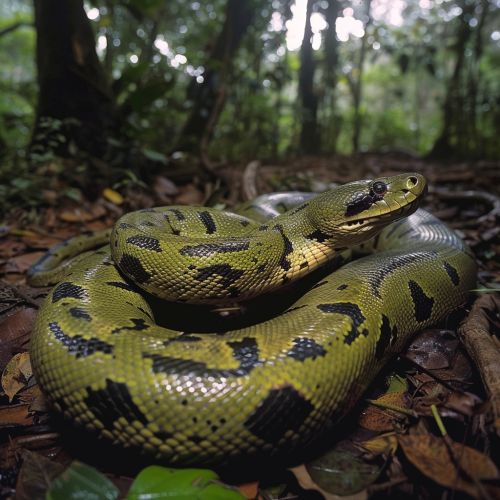Anaconda: Difference between revisions
(Created page with "== Introduction == The term "Anaconda" refers to a group of large, non-venomous snakes found in tropical South America. These snakes are part of the genus Eunectes, which is derived from the Greek word meaning "good swimmer." The most well-known species within this genus is the green anaconda (Eunectes murinus), which is one of the largest and heaviest snakes in the world. Other species include the yellow anaconda (Eunectes notaeus), the dark-spot...") |
No edit summary |
||
| Line 26: | Line 26: | ||
Anacondas are known for their immense size and girth. The green anaconda, in particular, can reach lengths of up to 30 feet (9 meters) and weigh as much as 550 pounds (250 kilograms). These snakes have thick, muscular bodies covered in smooth scales. The coloration varies among species, but green anacondas typically have an olive-green background with black blotches along their length. | Anacondas are known for their immense size and girth. The green anaconda, in particular, can reach lengths of up to 30 feet (9 meters) and weigh as much as 550 pounds (250 kilograms). These snakes have thick, muscular bodies covered in smooth scales. The coloration varies among species, but green anacondas typically have an olive-green background with black blotches along their length. | ||
[[Image:Detail-92231.jpg|thumb|center|A large green anaconda coiled on the forest floor, displaying its olive-green coloration with black blotches.|class=only_on_mobile]] | |||
[[Image:Detail-92232.jpg|thumb|center|A large green anaconda coiled on the forest floor, displaying its olive-green coloration with black blotches.|class=only_on_desktop]] | |||
== Habitat and Distribution == | == Habitat and Distribution == | ||
Latest revision as of 14:41, 17 June 2024
Introduction
The term "Anaconda" refers to a group of large, non-venomous snakes found in tropical South America. These snakes are part of the genus Eunectes, which is derived from the Greek word meaning "good swimmer." The most well-known species within this genus is the green anaconda (Eunectes murinus), which is one of the largest and heaviest snakes in the world. Other species include the yellow anaconda (Eunectes notaeus), the dark-spotted anaconda (Eunectes deschauenseei), and the Bolivian anaconda (Eunectes beniensis).
Taxonomy and Classification
Anacondas belong to the family Boidae, which also includes boas and pythons. The genus Eunectes is part of the subfamily Boinae. The classification of anacondas is as follows:
- Kingdom: Animalia
- Phylum: Chordata
- Class: Reptilia
- Order: Squamata
- Family: Boidae
- Subfamily: Boinae
- Genus: Eunectes
The genus Eunectes comprises four recognized species:
- Eunectes murinus (Green Anaconda)
- Eunectes notaeus (Yellow Anaconda)
- Eunectes deschauenseei (Dark-Spotted Anaconda)
- Eunectes beniensis (Bolivian Anaconda)
Physical Characteristics
Anacondas are known for their immense size and girth. The green anaconda, in particular, can reach lengths of up to 30 feet (9 meters) and weigh as much as 550 pounds (250 kilograms). These snakes have thick, muscular bodies covered in smooth scales. The coloration varies among species, but green anacondas typically have an olive-green background with black blotches along their length.


Habitat and Distribution
Anacondas are primarily found in the tropical rainforests, swamps, and marshes of South America. The green anaconda inhabits a wide range of environments, including the Amazon and Orinoco river basins. Yellow anacondas are more commonly found in Paraguay, southern Brazil, and northeastern Argentina. The dark-spotted anaconda is native to the northeastern regions of South America, while the Bolivian anaconda is found in the Beni region of Bolivia.
Behavior and Ecology
Anacondas are primarily aquatic and are excellent swimmers. They spend a significant amount of time in water, where they can move with ease and stealth. These snakes are solitary and nocturnal, hunting primarily at night. They are ambush predators, relying on their camouflage to surprise prey.
Diet
Anacondas are carnivorous and have a diverse diet that includes fish, birds, mammals, and even other reptiles. Larger individuals are capable of taking down substantial prey such as capybaras, deer, and caimans. They use constriction to subdue their prey, coiling around the animal and applying pressure until it suffocates.
Reproduction
Anacondas are ovoviviparous, meaning they give birth to live young. Mating occurs during the rainy season, and females can give birth to litters of 20 to 40 neonates, although larger litters have been recorded. The gestation period lasts about six months. Newborn anacondas are independent from birth and must fend for themselves.
Conservation Status
The conservation status of anacondas varies by species. The green anaconda is listed as "Least Concern" by the IUCN, while the yellow anaconda is considered "Near Threatened." Habitat destruction, hunting for their skins, and the pet trade pose significant threats to anaconda populations. Conservation efforts focus on habitat preservation and legal protection to ensure the survival of these remarkable reptiles.
Cultural Significance
Anacondas have a prominent place in the folklore and mythology of indigenous South American cultures. They are often depicted as powerful and mystical creatures. In modern popular culture, anacondas have been featured in films, books, and documentaries, sometimes exaggerating their size and danger to humans.
